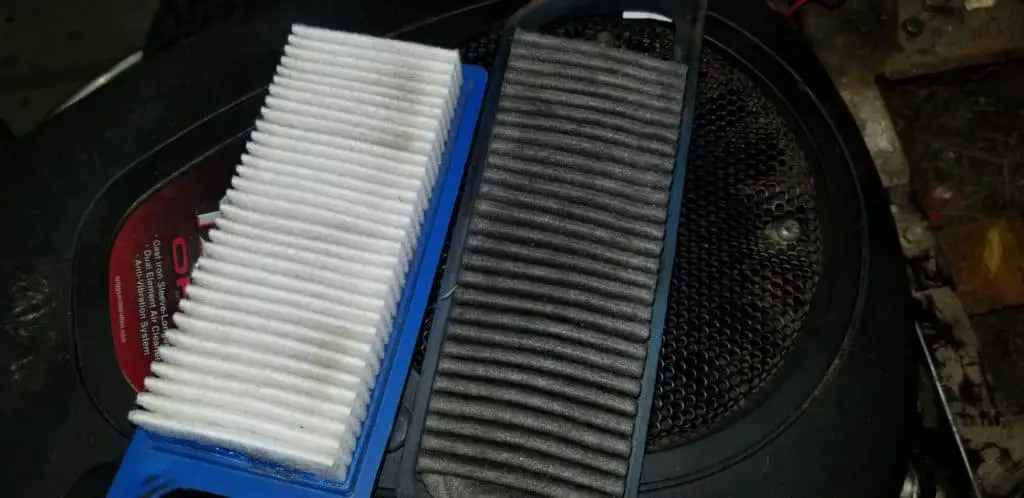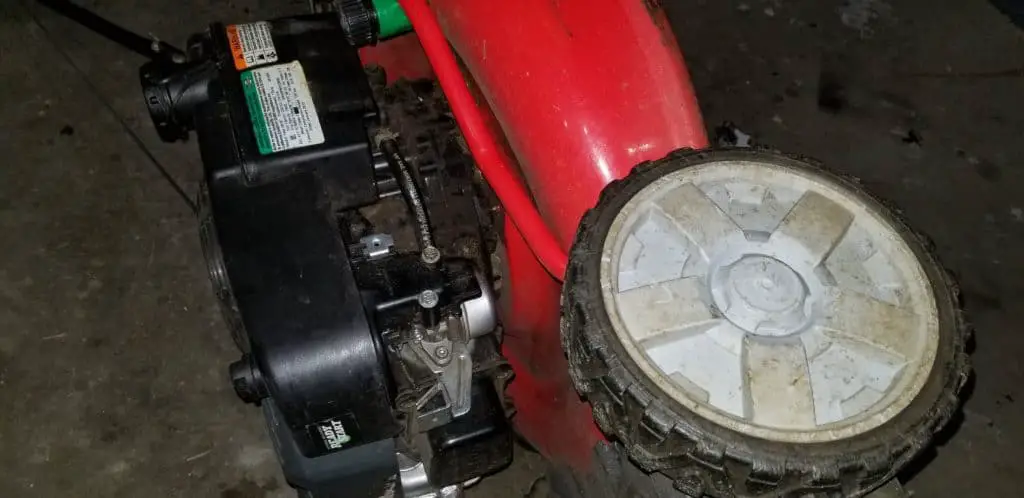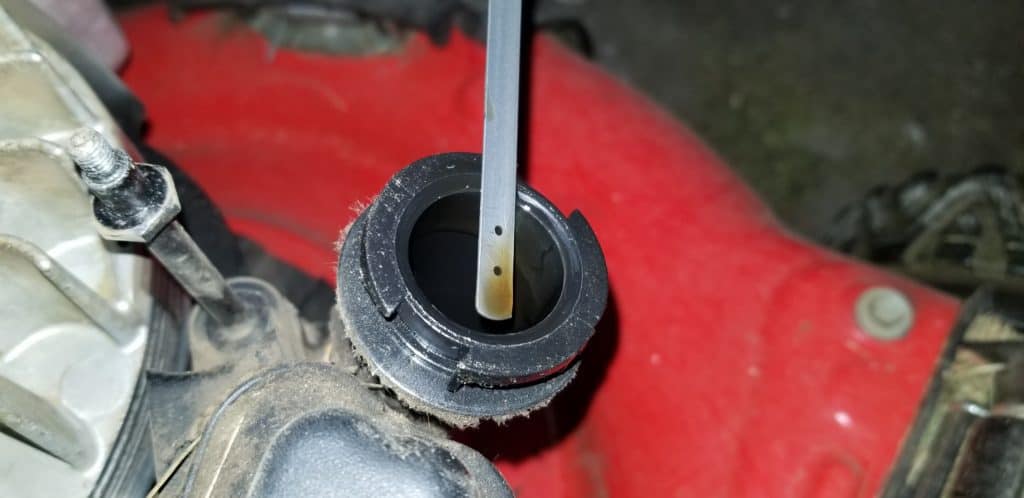Unless you’re trying to bring back the lost art of smoke signals, then I’m assuming you’re here to get your push mower fixed. Let’s skip the usual formalities of an intro paragraph and get right into why your lawn mower is keeping all of the mosquitoes away with plumes of white smoke from the exhaust!
As a general rule, a push mower will blow white smoke if it was tipped incorrectly and the air filter becomes saturated with engine oil from the crankcase, or if too much oil was added during the last oil change. Both result in oil being added to the combustion process and the result is white smoke.
That’s the quick and easy answer if you needed to make a quick gambling bet.
Below I’ve got a quick table that will take you through the primary reasons you’ll see white smoke from your lawn mower’s exhaust, followed by a detailed explanation and pictures of each, as well as a video tutorial.
From my seven years of repairing small engines as a side hustle, I can confidently say that 95% of your white smoke problems are from these two reasons:
| Reason for White Smoke | What Caused It | How to Fix |
|---|---|---|
| Air Filter too Dirty or Wet | Tipping the wrong way Overfilled Oil | Replace Air Filter Drain Excess Oil if Needed |
| Too Much Oil in Crankcase | Added Too Much During Oil Change | Drain Excess Oil Replace Air Filter if Needed |
Push Mower White Smoke Caused by an Oil-Soaked Air Filter and Overfilled Crankcase
I haven’t kept track of how many lawn mowers I’ve fixed with this problem, but it’s certainly been a common one and is probably responsible for 50% of all of the fixes that I’ve done over the last 7 years.
When a neighbor brings a mower to me with this problem, or if I snag a free mower on Marketplace with this problem, the first thing I do is pop off the cover to the air filter.
An air filter works best, ideally, when it’s clean, but it can certainly still work alright even if it’s dirty — as long as it is dry!

A wet air filter is NEVER going to work for anything other than allowing your mower to keep away all of the mosquitoes from a giant plume of white smoke.
If you pop off your air filter cover and notice that it is wet, or was wet at one time and is now really caked with dirt because of it, then you’re probably wondering what happened.
There’s a few reasons I can think of off the top of my head as to why your air filter is wet:
- Mower was tipped incorrectly and oil flooded the combustion chamber and air filter through the breathing tube
- Mower was overfilled with oil and excess pressure in the crank case is causing oil to run up the breather tube to the air filter
- Float needle is compromised in the carburetor and the gas is leaking out onto your air filter (inline models only) and after running for a while it will draw oil up for the reason mentioned in the bullet point above
If you got something stuck in your blades, or if you wanted to clear out matted grass from underneath the deck, it’s likely that you tipped over your lawn mower on one side or the other.
There’s a correct way to tip your mower over, and then there’s every other way that will cause smokey engine issues.
If you want a quick tutorial, I highly recommend checking out my other article here which will guide you through the process of turning any lawn mower (rider or push) on its side so that you don’t mess anything up.
In a nutshell though, you want to disconnect the spark plug for safety, and either tip the mower back on its handle (not usually ideal) or tip it so that the air filter and carburetor are facing up towards the sky. Before you tip it though, you want to get the piston at the top position during the compression stroke.
Again, the article above will guide you through this process.

If you tip it with the carburetor and the air filter down, then bad things happen. The oil in the crankcase can flow directly to the air filter via a small black tube called a “breather tube”. This tube serves to allow pressures to equalize in the crankcase (where the oil is) when the mower is upright and operating.
When you tip the mower over incorrectly, oil simply flows out of the mower and into the air filter.
Once your air filter becomes wet with oil, it changes the entire dynamic of the combustion process in your engine.
A lawnmower engine is a pump that tries to suck air and fuel in at 3,100 RPMs. Air can easily pass through a dry filter, but once it’s wet with oil the air can no longer get through or is severely restricted.
If the engine doesn’t stall, then it’s going to work its hardest to pull air from somewhere. While doing this, the negative pressure in the combustion chamber must be filled somehow if it is to stay running. It will try to suck more air out of the carburetor which will actually just cause it to suck more gas as well and run rich.
It will also try to suck air in from the crankcase by the piston rings which will inevitably allow oil to flow up and onto the piston.
Both excess gasoline and oil itself will smoke during the combustion process, which oil being more of a white color and gasoline being black.
The same concept applied to if you’ve overfilled the crankcase with oil during the last oil change. Make sure it’s in the acceptable range on your dipstick.
If it’s too high, the mower will have excess pressure in the crankcase because it won’t have enough air to work with and is instead full of a liquid oil. As the piston goes up and down at 3,100 times per minute, the buildup of the air pressure will displace the oil by forcing it up the breather tube and into your air filter, and by forcing it by the piston rings themselves.
An easy way to tell if you have to much oil without even checking the dipstick is to see if there is oil spray from the exhaust on top of your mower deck.
Tipping your mower wrong or overfilling with oil are the two most common reasons for getting a wet air filter. If your filter is still wet but you didn’t tip it, and your oil level is fine, then check to see if your air filter is inline with your carburetor.
By this, I mean that if something were to flow out of the carburetor that it would run into your air filter. An air filter located above the carburetor doesn’t count.
If your air filter is inline, then it is possible that your float needle in your carburetor is malfunctioning and causing gasoline to flood the carburetor. When it flows up and out of the bowl, it will either run into your engine or onto your air filter, depending on the angle and gravity.
In this case, you’ll need to pinch off the fuel line, remove your air filter assembly and carburetor. Remove the bowl of the carburetor and clean out the float needle seat area and replace any rubber components that are deformed or cracked.
Push Mower White Smoke Caused by Overfilling the Crankcase with Oil
I touched on this one a little bit above, but it is probably responsible for the other 50% of cases that I’ve dealt with that cause white smoke from a push mower’s exhaust.
Essentially if you overfill your engines crankcase with oil, then you disrupt the pressures that the engineers put in place within the engine itself during the combustion process.

Remember that air can be compressed, but liquids will not.
If you give the crankcase less air to work with since you dumped too much oil into it, then every time the piston drops down during the combustion process, it will increase the pressures within the crankcase.
The tolerances are now off and the increased pressure has to do something.
It will do either of the two things or both:
- Displace oil and drive it up through the breather tube and into your air filter (clogging it and increasing pressures even more)
- Displace oil and drive it passed the piston rings and into the combustion process (which will always lead to white smoke with oil)
The fix for this is simple. Just drain the excess oil until your dipstick is reading within the correct range.
Fire up the engine and try it again (after changing your wet air filter, of course).
It should be dramatically better but don’t be surprised if it still smokes for up to 15 minutes.
If you overfilled the engine oil, then there is likely liquid oil that is in the exhaust itself and needs to be burnt out by heat while the engine is running.
Push Mower White Smoke Caused by a Compromised Head Gasket
This one is going to be rare and will be more involved. I have not had it happen to any lawn mowers that I’ve repaired but I did have it happen with a generator.
The head gasket could be cracked either internally (between the combustion chamber and the push rods) or externally (between the push rods and the outside air, or between the combustion chamber and the outside air).
Any of these issues will result in weird air pressure changes within the crankcase and combustion chamber and can do all sorts of strange stuff with what you see coming out of the exhaust.
This is unlikely to be your problem, but I thought I’d mention it if draining your excess oil and replacing your air filter don’t work.
This is a job that can be done by yourself, but I would rate it as moderate as far as mechanical abilities. If it’s your first time, it would definitely feel like a hard job to do.
Other Possible Reasons for White Smoke from a Push Mower
I thought I’d throw in a few honorable mentions into the mix. We covered the two main ones, but these could haunt you — especially if you got your lawn mower used and don’t know the history behind it.
Make sure your oil is the correct type for your mower. Consult your manual if you’d like, but in North America during the summer you can use SAE-30, 5W-30, or 10W-30 without a problem.
If your oil is incorrect (especially too thin) it could lead to oil seeping by the piston rings and burning up during combustion.
If you have gas that got mixed into your oil by tipping the mower the wrong way, then you could also have thinner oil and this could lead to white smoke as it gets by the piston rings.
If anyone has used 2-cycle engine oil, this could do some pretty strange stuff as well.
It’s more common with snowblowers with ice forming inside, but if your breather tube that runs from your crankcase to your air filter is clogged by something, then it would change pressures and allow for oil to work passed the piston rings.
